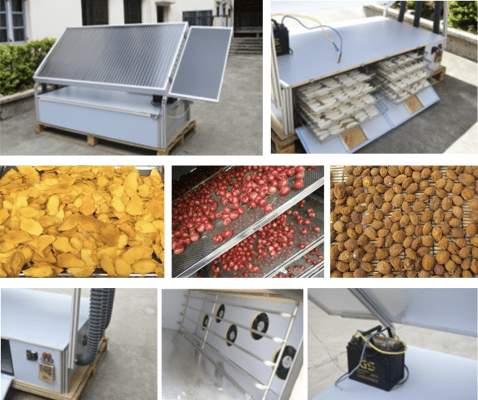
Harnessing Solar Energy: A Detailed Guide to Drying Fruits, Vegetables, and Herbs using a Solar Dryer
- Description details
-
A solar dryer is a device that uses the sun's energy to dry your food. It uses solar thermal energy to heat up air, which then moves through a specially designed chamber and dries the food. Here is a general explanation of how solar dryers work, and how they can be used to dry various types of vegetables, fruits, and herbs:
**Basic Working Principle:**
1. **Absorption of solar energy:** Solar dryers capture and absorb the sun's energy in a 'solar collector'. The solar collector is a dark-colored surface which attracts and absorbs heat from the sun.
2. **Heating of air:** The heat absorbed warms up the air in the solar collector.
3. **Air circulation:** The hot air then rises and circulates around the food on the drying trays. The moisture in the food evaporates into this circulating air, and the dry air absorbs this moisture.
4. **Evaporation of moisture:** As the dry air absorbs the moisture from the food, it becomes humid and heavy, and it is vented out of the dryer, while new, dry air is pulled in to replace it. This process continues until the food is dried.
**Solar Drying of Vegetables, Fruits, and Herbs:**
When it comes to drying specific types of produce, the process remains the same, but the preparation might differ.
**Vegetables:** For vegetables like Mchicha, Tembel, Chainiz, Mchunga, Mboga ya muhogo, Tomatoes, Onion, Garlic, Bilngan, and Ginger, they should first be washed thoroughly and then cut into uniform thin slices. This promotes even drying. Once sliced, they can be spread out on the dryer's trays.
**Fruits:** Fruits like Pumpkin, Paw paw, Pineapple, Banana, Lime, Jackfruit, Shelisheli, Cassava, Mango, and Sweet potatoes should also be washed, peeled (where applicable), and cut into thin, uniform slices. Acidic fruits like pineapple and mango can be pre-treated with ascorbic acid to prevent browning during drying. Fruits with high sugar content may need to be blanched before drying to stop the sugar from crystallizing on the surface.
**Herbs:** Herbs like Rosemary, Sage, and Lavender should be washed and the leaves removed from the stem. Herbs can be dried whole or chopped, but remember that whole leaves will retain their flavor longer. They should be spread in a single layer on the drying tray.
Regardless of the type of produce, it is crucial to maintain a constant check on the drying process, as over-drying can lead to loss of flavor and nutrients, while under-drying can lead to the growth of mold.
Finally, after drying, the produce should be packed in airtight containers to prevent moisture absorption and stored in a cool, dark place for maximum shelf life.
Remember that solar drying depends heavily on weather conditions, so it might take a while to get a feel for how long it will take to dry different types of produce in your specific location. Patience is key.
Please note, it is also essential to follow food safety guidelines while handling and processing food to prevent contamination.
- For more information
-
For more information:
